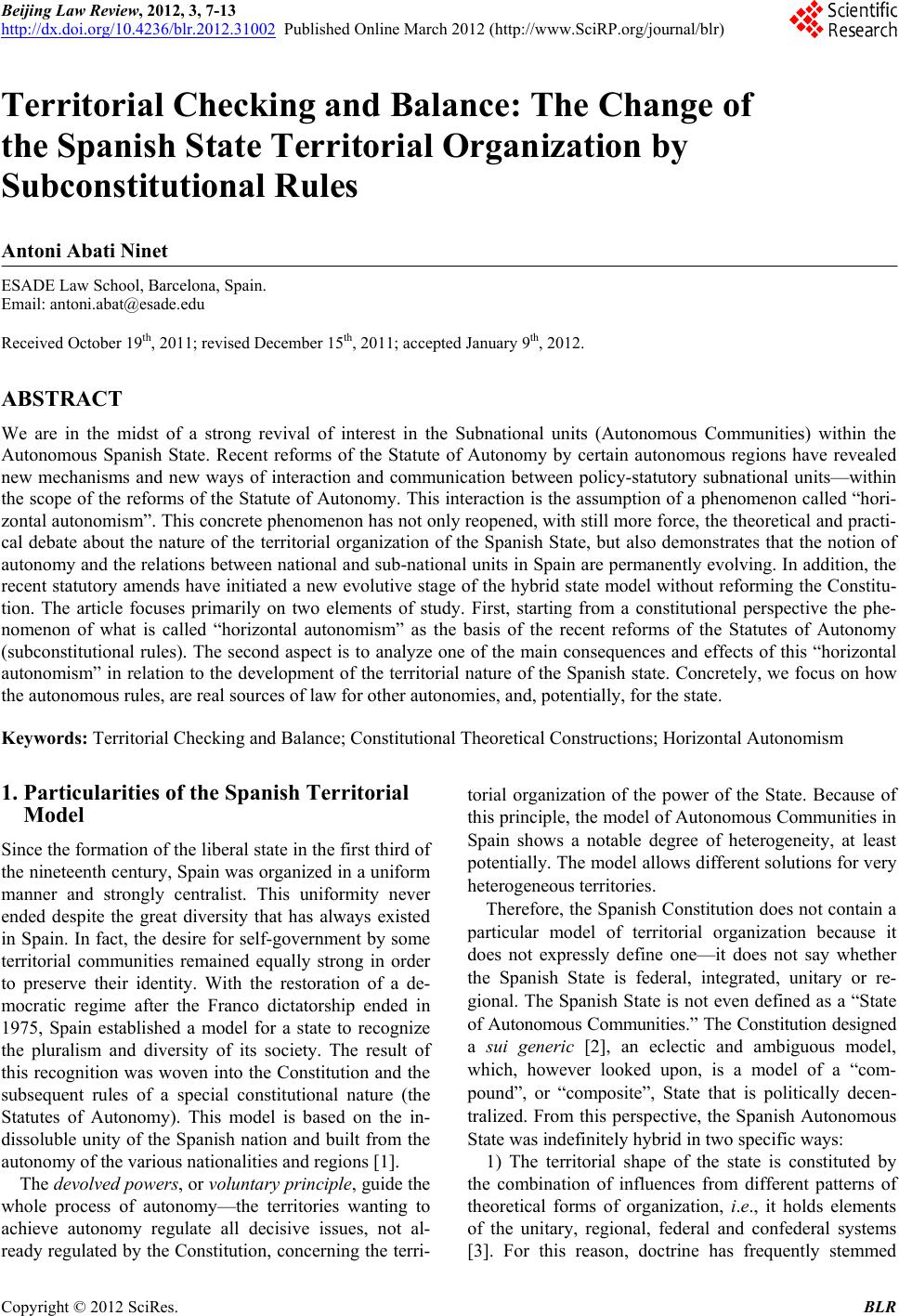 Beijing Law Review, 2012, 3, 7-13 http://dx.doi.org/10.4236/blr.2012.31002 Published Online March 2012 (http://www.SciRP.org/journal/blr) 7 Territorial Checking and Balance: The Change of the Spanish State Territorial Organization by Subconstitutional Rules Antoni Abati Ninet ESADE Law School, Barcelona, Spain. Email: antoni.abat@esade.edu Received October 19th, 2011; revised December 15th, 2011; accepted January 9th, 2012. ABSTRACT We are in the midst of a strong revival of interest in the Subnational units (Autonomous Communities) within the Autonomous Spanish State. Recent reforms of the Statute of Autonomy by certain autonomous regions have revealed new mechanisms and new ways of interaction and communication between policy-statutory subnational units—within the scope of the reforms of the Statute of Autonomy. This interaction is the assumption of a phenomenon called “hori- zontal autonomism”. This concrete phenomeno n has not only reopened, with still more fo rce, the th eoretical and practi- cal debate about the nature of the territorial organization of the Spanish State, but also demonstrates that the notion of autonomy and the relations between national and sub-national units in Spain are permanently evolving. In addition, the recent statutory amends have initiated a new evolutive stage of the hybrid state model without reforming the Constitu- tion. The article focuses primarily on two elements of study. First, starting from a constitutional perspective the phe- nomenon of what is called “horizontal autonomism” as the basis of the recent reforms of the Statutes of Autonomy (subconstitutional rules). The second aspect is to analyze one of the main consequences and effects of this “horizontal autonomism” in relation to the development of the territorial nature of the Spanish state. Concretely, we focus on how the autonomous rules, are real sources of law for other autonomies, and, potentially, for the state. Keywords: Territorial Checking and Balance; Constitutional Theoretical Constructions ; Horizontal Autonomism 1. Particularities of the Spanish Territorial Model Since the formation of the liberal state in the first third of the nineteenth century, Spain was organized in a uniform manner and strongly centralist. This uniformity never ended despite the great diversity that has always existed in Spain. In fact, the desire for self-government by some territorial communities remained equally strong in order to preserve their identity. With the restoration of a de- mocratic regime after the Franco dictatorship ended in 1975, Spain established a model for a state to recognize the pluralism and diversity of its society. The result of this recognition was woven into the Constitution and the subsequent rules of a special constitutional nature (the Statutes of Autonomy). This model is based on the in- dissoluble unity of the Spanish nation and built from the autonomy of the various nationalities and regions [1]. The devolved powers, or voluntary principle, guide the whole process of autonomy—the territories wanting to achieve autonomy regulate all decisive issues, not al- ready regulated by the Constitution, con cerning the terri- torial organization of the power of the State. Because of this principle, the model of Autonomous Communities in Spain shows a notable degree of heterogeneity, at least potentially. The model allows d ifferent solutions for very heteroge neous te rri tories. Therefore, the Spanish Constitution does not contain a particular model of territorial organization because it does not expressly define one—it does not say whether the Spanish State is federal, integrated, unitary or re- gional. The Spanish State is not even defined as a “State of Autonomous Communities.” The Constitution designed a sui generic [2], an eclectic and ambiguous model, which, however looked upon, is a model of a “com- pound”, or “composite”, State that is politically decen- tralized. From this perspective, the Spanish Autonomous State was indefinitely hybrid in two specific ways: 1) The territorial shape of the state is constituted by the combination of influences from different patterns of theoretical forms of organization, i.e., it holds elements of the unitary, regional, federal and confederal systems [3]. For this reason, doctrine has frequently stemmed Copyright © 2012 SciRes. BLR 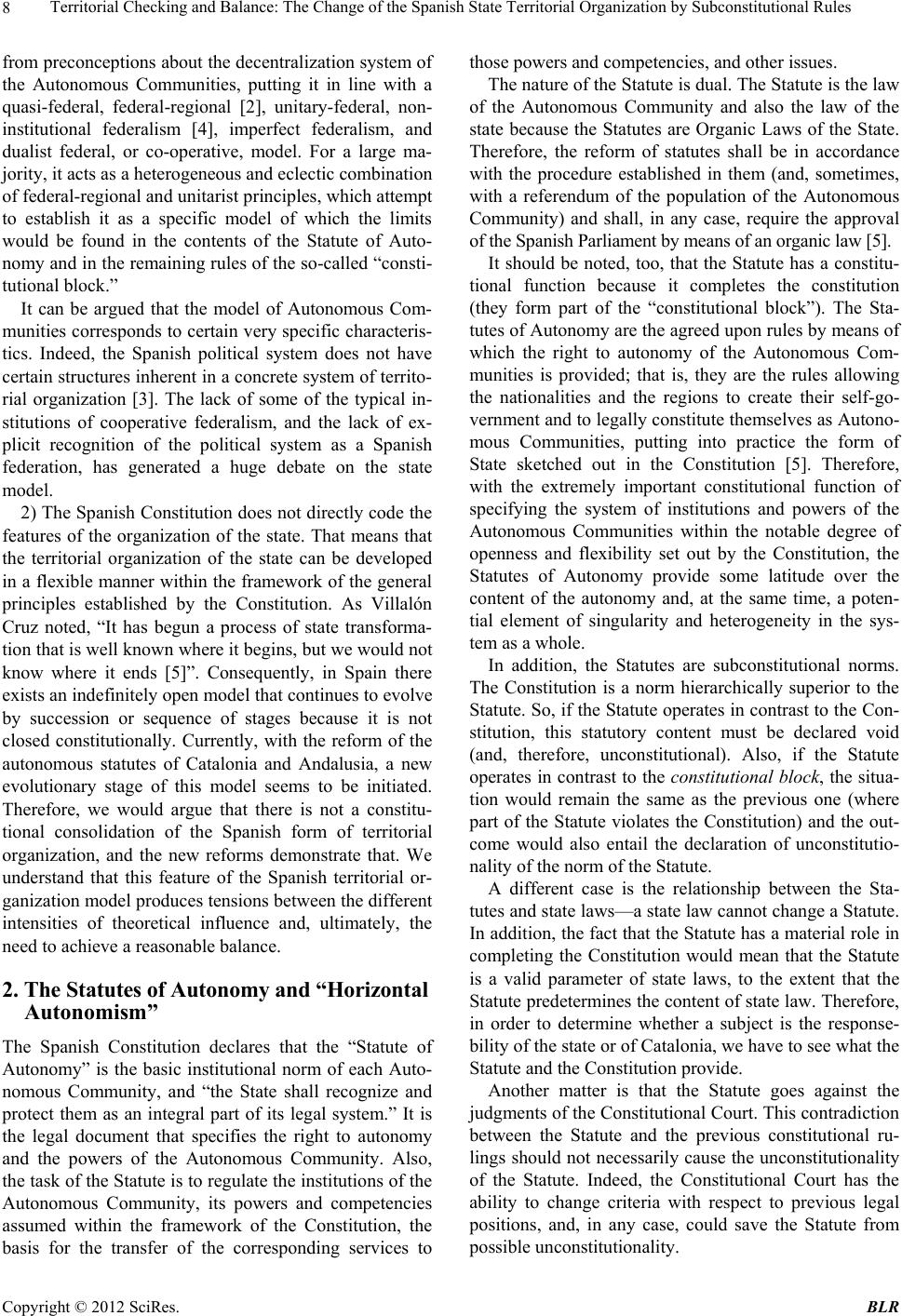 Territorial Checking and Balance: The Change of the Spanish State Territorial Organization by Subconstitutional Rules 8 from preconceptions about the decentralization system of the Autonomous Communities, putting it in line with a quasi-federal, federal-regional [2], unitary-federal, non- institutional federalism [4], imperfect federalism, and dualist federal, or co-operative, model. For a large ma- jority, it acts as a heterogeneous and eclectic combination of federal-regional and unitarist principles, which attempt to establish it as a specific model of which the limits would be found in the contents of the Statute of Auto- nomy and in the remaining rules of the so-called “cons ti- tutional bloc k.” It can be argued that the model of Autonomous Com- munities corresponds to certain very specific characteris- tics. Indeed, the Spanish political system does not have certain structures inherent in a concrete system of territo- rial organization [3]. The lack of some of the typical in- stitutions of cooperative federalism, and the lack of ex- plicit recognition of the political system as a Spanish federation, has generated a huge debate on the state model. 2) The Span ish Constitution does not d irectly code the features of the organization of the state. That means that the territorial organization of the state can be developed in a flexible mann er within the framework of the general principles established by the Constitution. As Villalón Cruz noted, “It has begun a process of state transforma- tion that is well known where it begins, but we would not know where it ends [5]”. Consequently, in Spain there exists an indefinitely open model that continues to evolve by succession or sequence of stages because it is not closed constitutionally. Currently, with the reform of the autonomous statutes of Catalonia and Andalusia, a new evolutionary stage of this model seems to be initiated. Therefore, we would argue that there is not a constitu- tional consolidation of the Spanish form of territorial organization, and the new reforms demonstrate that. We understand that this feature of the Spanish territorial or- ganization model produces tensions between the different intensities of theoretical influence and, ultimately, the need to achieve a reasonable balance. 2. The Statutes of Autonomy and “Horizontal Autonomism” The Spanish Constitution declares that the “Statute of Autonomy” is the basic institutional norm of each Auto- nomous Community, and “the State shall recognize and protect them as an integral part of its legal system.” It is the legal document that specifies the right to autonomy and the powers of the Autonomous Community. Also, the task of the Statute is to regulate the institu tions of the Autonomous Community, its powers and competencies assumed within the framework of the Constitution, the basis for the transfer of the corresponding services to those powers and competencies, and other issues. The nature of the Statute is dual. The Statute is the law of the Autonomous Community and also the law of the state because the Statutes are Organic Laws of the State. Therefore, the reform of statutes shall be in accordance with the procedure established in them (and, sometimes, with a referendum of the population of the Autonomous Community) and shall, in any case, require the approval of the Spanish Parliament by means of an organic law [5] . It should be noted, too, that the Statute has a constitu- tional function because it completes the constitution (they form part of the “constitutional block”). The Sta- tutes of Autonomy are the agreed upon rules by means of which the right to autonomy of the Autonomous Com- munities is provided; that is, they are the rules allowing the nationalities and the regions to create their self-go- vernment and to legally con stitute themselves as Autono- mous Communities, putting into practice the form of State sketched out in the Constitution [5]. Therefore, with the extremely important constitutional function of specifying the system of institutions and powers of the Autonomous Communities within the notable degree of openness and flexibility set out by the Constitution, the Statutes of Autonomy provide some latitude over the content of the autonomy and, at the same time, a poten- tial element of singularity and heterogeneity in the sys- tem as a whole. In addition, the Statutes are subconstitutional norms. The Constitution is a norm hierarchically superior to the Statute. So, if the Statute operates in contrast to the Con- stitution, this statutory content must be declared void (and, therefore, unconstitutional). Also, if the Statute operates in contrast to the constitutional block, the situa- tion would remain the same as the previous one (where part of the Statute violates the Constitution) and the out- come would also entail the declaration of unconstitutio- nality of the norm of the Statute. A different case is the relationship between the Sta- tutes and state laws—a state law cannot change a Statute. In addition, the fact that the Statute has a material role in completing the Constitution would mean that the Statute is a valid parameter of state laws, to the extent that the Statute predetermines the content of state law. Therefore, in order to determine whether a subject is the response- bility of the state or of Catalonia, we have to see what the Statute and the Constitutio n provide. Another matter is that the Statute goes against the judgments of the Con stitutional Co urt. This contrad iction between the Statute and the previous constitutional ru- lings should not necessarily cause the unconstitutionality of the Statute. Indeed, the Constitutional Court has the ability to change criteria with respect to previous legal positions, and, in any case, could save the Statute from possible unconstitutionality. Copyright © 2012 SciRes. BLR 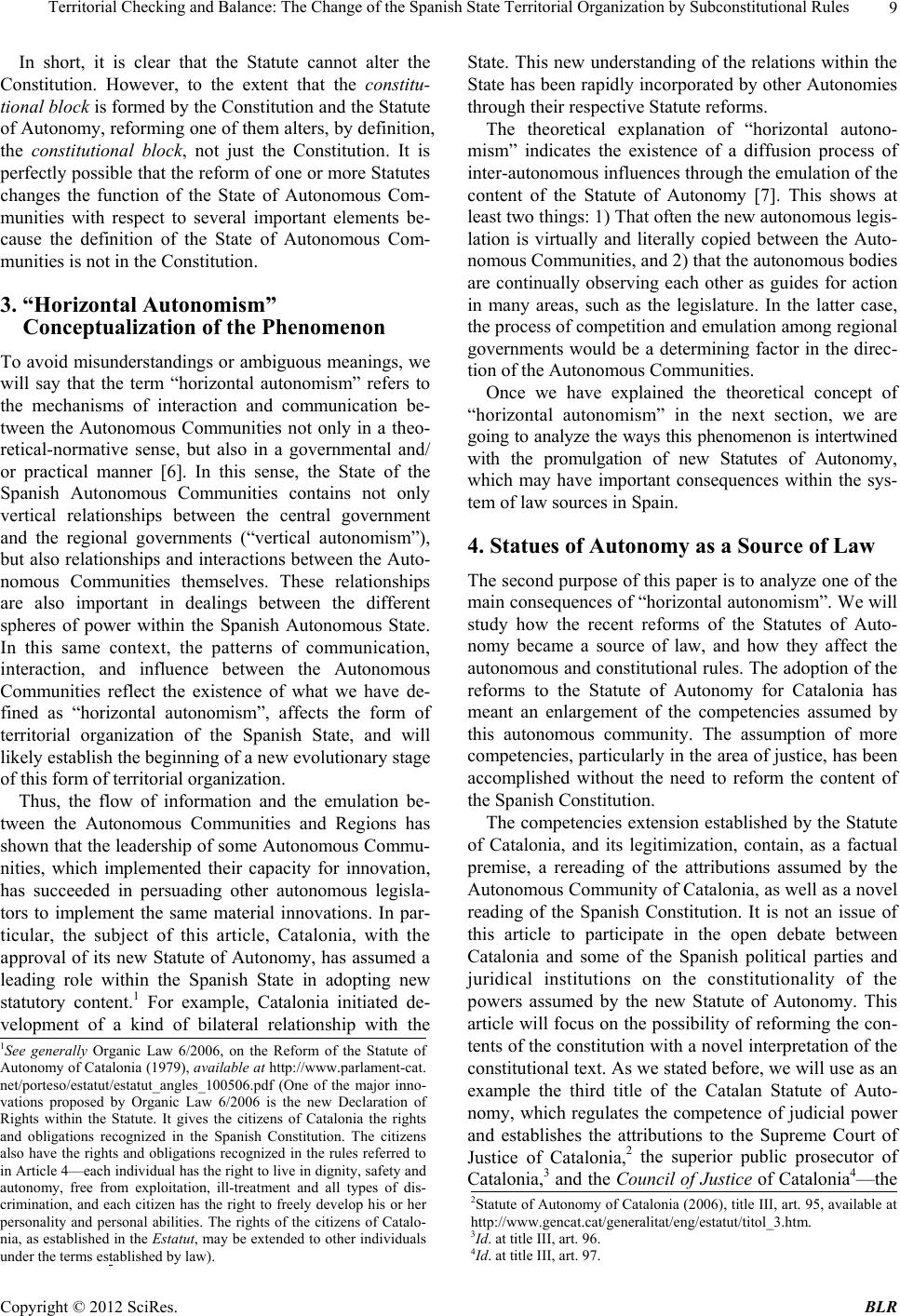 Territorial Checking and Balance: The Change of the Spanish State Territorial Organization by Subconstitutional Rules 9 In short, it is clear that the Statute cannot alter the Constitution. However, to the extent that the constitu- tional block is formed by the Constitution and the Statute of Autonomy, reforming one of them alters, by definition, the constitutional block, not just the Constitution. It is perfectly possible that the reform of one or more Statutes changes the function of the State of Autonomous Com- munities with respect to several important elements be- cause the definition of the State of Autonomous Com- munities is not in the Constitution. 3. “Horizontal Autonomism” Conceptualization of the Phenomenon To avoid misunderstandings or ambiguous meanings, we will say that the term “horizontal autonomism” refers to the mechanisms of interaction and communication be- tween the Autonomous Communities not only in a theo- retical-normative sense, but also in a governmental and/ or practical manner [6]. In this sense, the State of the Spanish Autonomous Communities contains not only vertical relationships between the central government and the regional governments (“vertical autonomism”), but also relationships and interactions between the Auto- nomous Communities themselves. These relationships are also important in dealings between the different spheres of power within the Spanish Autonomous State. In this same context, the patterns of communication, interaction, and influence between the Autonomous Communities reflect the existence of what we have de- fined as “horizontal autonomism”, affects the form of territorial organization of the Spanish State, and will likely establish the beginning of a new evolutionary stage of this form of territorial or ganization. Thus, the flow of information and the emulation be- tween the Autonomous Communities and Regions has show n that the lead ersh ip of some Auto nomous Commu- nities, which implemented their capacity for innovation, has succeeded in persuading other autonomous legisla- tors to implement the same material innovations. In par- ticular, the subject of this article, Catalonia, with the ap proval of its new Statute of Autonomy, has assumed a leading role within the Spanish State in adopting new statutory content.1 For example, Catalonia initiated de- velopment of a kind of bilateral relationship with the State. This new understanding of the relations within the State has been rapidly incorporated by other Autonomies through their resp ective Statute reforms. The theoretical explanation of “horizontal autono- mism” indicates the existence of a diffusion process of inter-autonomous influences through the emulation of the content of the Statute of Autonomy [7]. This shows at least two things: 1) That often th e new auton o mous leg is- lation is virtually and literally copied between the Auto- nomous Communities, an d 2) that th e au tono mous bodies are continually observing each other as guides for action in many areas, such as the legislature. In the latter case, the process of competition and emulation among regional governments would be a determining factor in the direc- tion of the Autonomous Communities. Once we have explained the theoretical concept of “horizontal autonomism” in the next section, we are going to analyze the ways this phenomenon is intertwined with the promulgation of new Statutes of Autonomy, which may have important consequences within the sys- tem of law sources in Spain. 4. Statues of Autonomy as a Source of Law The second purpose of this paper is to analyze one of the main consequences of “horizontal auton omism”. We will study how the recent reforms of the Statutes of Auto- nomy became a source of law, and how they affect the autonomous and con stitutional rules. The adoption of the reforms to the Statute of Autonomy for Catalonia has meant an enlargement of the competencies assumed by this autonomous community. The assumption of more competencies, particularly in the area of justice, has been accomplished without the need to reform the content of the Spanish Constitu tion. The competencies extension established by the Statute of Catalonia, and its legitimization, contain, as a factual premise, a rereading of the attributions assumed by the Autonomous Community of Catalonia, as well as a novel reading of the Spanish Constitution. It is not an issue of this article to participate in the open debate between Catalonia and some of the Spanish political parties and juridical institutions on the constitutionality of the powers assumed by the new Statute of Autonomy. This article will focus on the possibility o f reforming the con- tents of the constitu tion with a novel interpretation of the constitutional text. As we stated before, we will u se as an example the third title of the Catalan Statute of Auto- nomy, which regulates the competence of judicial power and establishes the attributions to the Supreme Court of Justice of Catalonia,2 the superior public prosecutor of Catalonia,3 and the Council of Justice of Catalonia4—the 1See generally Organic Law 6/2006, on the Reform of the Statute o Autonomy of Catalonia (1979), available at http://www.parlament-cat. net/porteso/estatut/estatut_angles_100506.pdf (One of the major inno- vations proposed by Organic Law 6/2006 is the new Declaration o Rights within the Statute. It gives the citizens of Catalonia the rights and obligations recognized in the Spanish Constitution. The citizens also have the rights and obligations recognized in the rules referred to in Article 4—each individual has the right to live in dignity, safety and autonomy, free from exploitation, ill-treatment and all types of dis- crimination, and each citizen has the right to freely develop his or her ersonality and personal abilities. The rights of the citizens of Catalo- nia, as established in the Estatut, may be extended to other individuals under the terms established by law). 2Statute of Autonomy of Catalonia (2006), title III, art. 95, available at http://www.gencat.cat/generalitat/eng/estatut/titol_3.htm. 3Id. at title III, art. 96. 4 d. at title III, art. 97. Copyright © 2012 SciRes. BLR  Territorial Checking and Balance: The Change of the Spanish State Territorial Organization by Subconstitutional Rules 10 competencies assumed by the Catalan Government (Ge- neralitat d e Catalunya) over the administration of justice. Article 109 of the third title establishes a subrogation clause that states that the Catalan Government will exer- cise all the functions an d competencies expressly granted by the statute and all the faculties that the Organic Law recognizes in the State Government in relation to the administ rat i on of just i ce. The establishment of the Council of Justice of Catalo- nia has resulted in cries of unconstitutionality by the Ombudsman, who alleges that this new institution (Con- sell de justicia) would act without regard for the Judges of the (Consejo General del Poder Judicial), creating a sort of “alternative justice” under the exclusive control of the Catalan Government. The Ombudsman upholds in his recourse political arguments and administrative norms, instead of fundamental principles, such as the principle of proximity of justice to th e action. A fundamental prin- ciple should prevail over a competent norm, and more citizens should be made aware that the proximity of jus- tice and the approach of the justice to the action are fun- damental objectives marking Spanish law of judicial power. An agile and nearby justice will lift the citizens’ confidence in the judicial system and will be truly sensi- tive to the special peculiarities and singularities of a plu- ral Spain. Likewise, the decentralization of the judicial system could be a key factor in the necessary improve- ment of the justice system in the Spanish State. The in- troduction of more legal institutions with an active par- ticipation in the judicial system would help relieve the number of judicial matters brought to the State judicial organs. The application of structural changes, and making active participation of the Autonomous Communities feasible, will overcome the aphorism applied to the states that “slow justice is not justice,” because the justice will stop being dramatically slow. Consequently, with the independence of th e conflict competent, the interests and rights of the citizens should predominate—that is to say, the norm to apply should be the one that offers better rights, or more rights, to the citizenship. Contemplating this norm, we expect that the Spanish constitutional syste m as a whole will be analogous to the American state constitution’s new interpretative era. In the United States, the late twentieth century state and federal judges, along with legal academics, recognized the potential of state con stitutions as an important source of law. As James Gardner affirms that when state courts merely “consult” similar decisions from other jurisdic- tions, they are conventionally understood to be doing something optional, and the consulting court typically considers itself equally free to attend to or to ignore the consulted opinions [8]. Consultation, in other words, is not premised on a belief that judicial rulings from other jurisdictions are in any sense binding within the consult- ing jurisdiction [8]. Gardner states that the state courts must do more than merely “consult” federal constitu- tional law in the hope that su ch a ch ance en counter migh t yield useful ideas or arguments [8]. We demand this kind of effort from the Autonomous governments and institu- tions to develop this kind of cooperative relationship between the Autonomous Communities and the State. In one sense, it is cooperative autonomism—a system of participation of member States in a federation and col- laboration amongst them all. While in Spain the distribution of powers has deve- loped rapidly, the participation by Autonomous Commu- nities in the State through proper collaboration has not progressed according to the parameters of federal state institutions. Althou gh the Constitutiona l Court has stated that collaboration is a duty of the State and the Autono- mous Communities, the lack of cooperativ e institutio ns is possibly the most prominent failure of the State of the Autonomous Communities. The Autonomous Communities are unable to contri- bute to the formation of national public policies, due to the lack of appropriate institutions. In Spain, the few meetings between the different administrations rarely create policies of joint government. Mostly, there are bilateral negotiations between the central government and a particular autonomous community in which each party tries to get support for its own policies. It has been argued that multilateral meetings with all the Autono- mous Communities operate against the principle of autonomy, since it involves giving up the political orient- tation of each territory. Thus, the cooperation in Spain tends to consist of an exchange of favors and is confined to the moments in which the two political forces are needed and can benefit each other. All federal states have constitutional courts or supreme courts in charge of settling disputes which may arise among the different levels of government. These courts have a monopoly (e.g., the constitutional courts in Spain and other European states) or the last word (e.g., the United States Supreme Courts) on the interpretation of the constitution . In federal states, this power includes the interpretation of the separation of powers between the different territorial governments. This feature is one of the tasks of constitutional courts. The federal systems must ensure the neutrality of those courts respon sible for resolving jurisdictional conflicts between different levels of government. This, for example, has implications re- garding the equal participation of the parties in the ap- pointment and renewal of j ud ge s. In Spain, the role of the Constitutional Court as a me- diator in conflicts between different levels of gov ernment is very important for, at least, two reasons. On the one hand, the lack of institutions that facilitate communica- tion and negotiation between the central power and the Copyright © 2012 SciRes. BLR 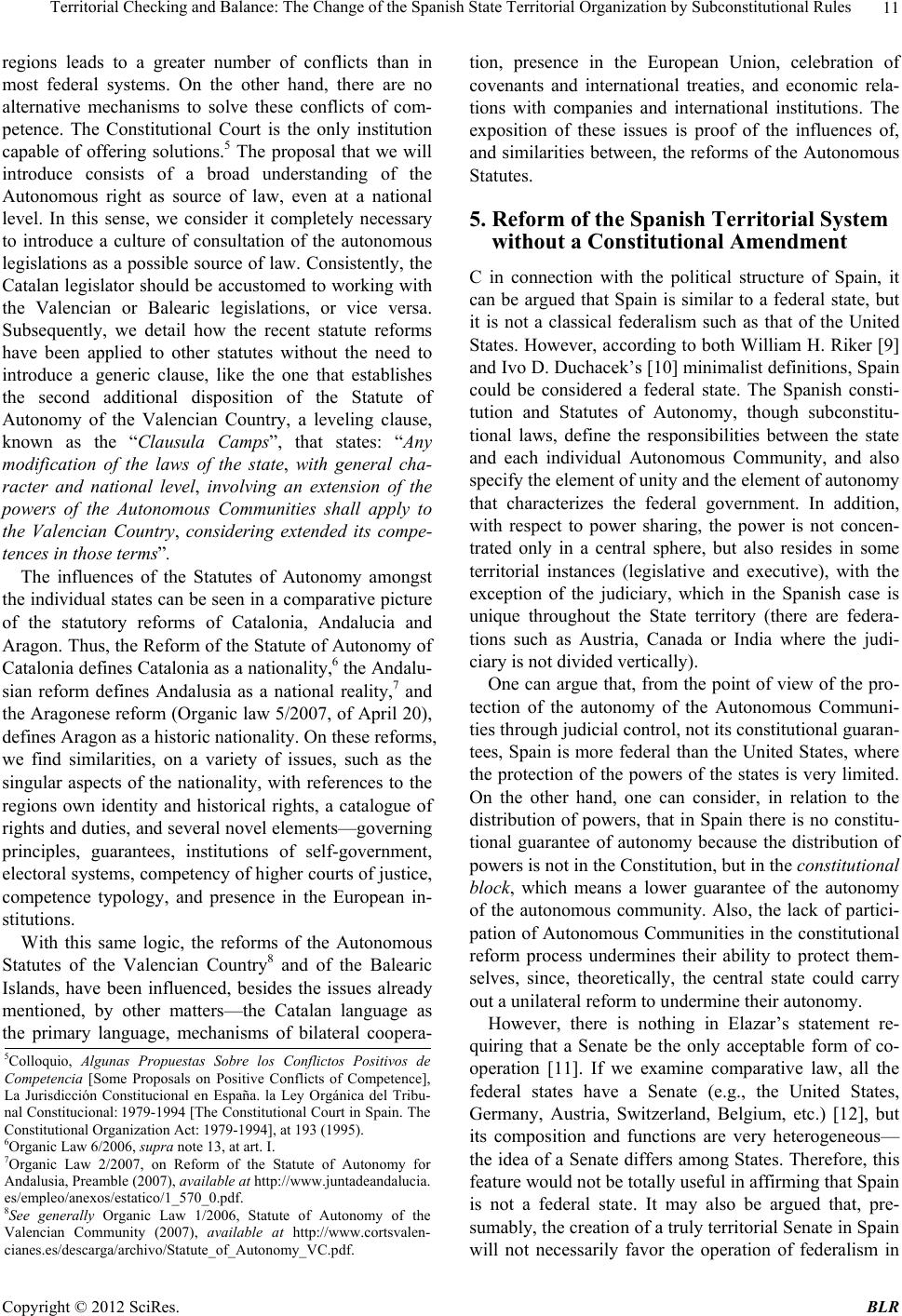 Territorial Checking and Balance: The Change of the Spanish State Territorial Organization by Subconstitutional Rules 11 regions leads to a greater number of conflicts than in most federal systems. On the other hand, there are no alternative mechanisms to solve these conflicts of com- petence. The Constitutional Court is the only institution capable of offering solutions.5 The proposal that we will introduce consists of a broad understanding of the Autonomous right as source of law, even at a national level. In this sense, we consider it completely necessary to introduce a culture of consultation of the autonomous legislations as a possible source of law. Consistently, the Catalan legislator shou ld be accustomed to working with the Valencian or Balearic legislations, or vice versa. Subsequently, we detail how the recent statute reforms have been applied to other statutes without the need to introduce a generic clause, like the one that establishes the second additional disposition of the Statute of Autonomy of the Valencian Country, a leveling clause, known as the “Clausula Camps”, that states: “Any modification of the laws of the state, with general cha- racter and national level, involving an extension of the powers of the Autonomous Communities shall apply to the Valencian Country, considering extended its compe- tences in those terms”. The influences of the Statutes of Autonomy amongst the individual states can be seen in a comparative picture of the statutory reforms of Catalonia, Andalucia and Aragon. Thus, the Reform of the Statute of Autonomy of Catalonia defines Catalonia as a nationality,6 the Andalu- sian reform defines Andalusia as a national reality,7 and the Aragonese reform (Organic law 5/2007, of April 20), defines Aragon as a historic nationality. On these reforms, we find similarities, on a variety of issues, such as the singular aspects of the nationality, with references to the regions own identity and historical rights, a catalogue of rights and duties, and several novel elements—governing principles, guarantees, institutions of self-government, electoral systems, competency of higher courts of justice, competence typology, and presence in the European in- stitutions. With this same logic, the reforms of the Autonomous Statutes of the Valencian Country8 and of the Balearic Islands, have been influenced, besides the issues already mentioned, by other matters—the Catalan language as the primary language, mechanisms of bilateral coopera- tion, presence in the European Union, celebration of covenants and international treaties, and economic rela- tions with companies and international institutions. The exposition of these issues is proof of the influences of, and similarities between, the reforms of the Autonomous Statutes. 5. Reform of the Spanish Territorial System without a Constitutional Amendment C in connection with the political structure of Spain, it can be argued that Spain is similar to a federal state, but it is not a classical federalism such as that of the United States. However, according to both William H. Riker [9] and Ivo D. Duchacek’s [10] minimalist definitions, Spain could be considered a federal state. The Spanish consti- tution and Statutes of Autonomy, though subconstitu- tional laws, define the responsibilities between the state and each individual Autonomous Community, and also specify the element of unity and the element of autonomy that characterizes the federal government. In addition, with respect to power sharing, the power is not concen- trated only in a central sphere, but also resides in some territorial instances (legislative and executive), with the exception of the judiciary, which in the Spanish case is unique throughout the State territory (there are federa- tions such as Austria, Canada or India where the judi- ciary is not divided vertically). One can argue that, from the point of view of the pro- tection of the autonomy of the Autonomous Communi- ties through judicial con trol, not its con stitu tion al gu aran- tees, Spain is more federal than the United States, where the protection of the powers of the states is very limited. On the other hand, one can consider, in relation to the distribution of powers, that in Spain there is no constitu- tional guarantee of autonomy because the distribution of powers is not in the Constitution, but in the constitutional block, which means a lower guarantee of the autonomy of the autonomous community. Also, the lack of partici- pation of Autono mous Communities in the co nstitutional reform process undermines their ability to protect them- selves, since, theoretically, the central state could carry out a unilateral reform to undermine their autonomy. However, there is nothing in Elazar’s statement re- quiring that a Senate be the only acceptable form of co- operation [11]. If we examine comparative law, all the federal states have a Senate (e.g., the United States, Germany, Austria, Switzerland, Belgium, etc.) [12], but its composition and functions are very heterogeneous— the idea of a Senate differs among States. Therefore, this feature would not be totally useful in affirming that Spain is not a federal state. It may also be argued that, pre- sumably, the creation of a truly territorial Sen ate in Spain will not necessarily favor the operation of federalism in 5Colloquio, lgunas Propuestas Sobre los Conflictos Positivos de Competencia [Some Proposals on Positive Conflicts of Competence], La Jurisdicción Constitucional en España. la Ley Orgánica del Tribu- nal Constitucional: 1979-1994 [The Constitutional Court in Spain. The Constitutional Organization Act: 19 79 - 19 9 4] , a t 1 93 (1 9 95 ) . 6Organic Law 6/2006, supra note 13, at art. I. 7Organic Law 2/2007, on Reform of the Statute of Autonomy for Andalusia, Preamble (2007), available at http://www.juntadeandalucia. es/empleo/anexos/estatico/1_570_0.pdf. 8See generally Organic Law 1/2006, Statute of Autonomy of the Valencian Community (2007), available at http://www.cortsvalen- cianes.es/descarga/archivo/Statute_of_Autonomy_VC.pdf. Copyright © 2012 SciRes. BLR 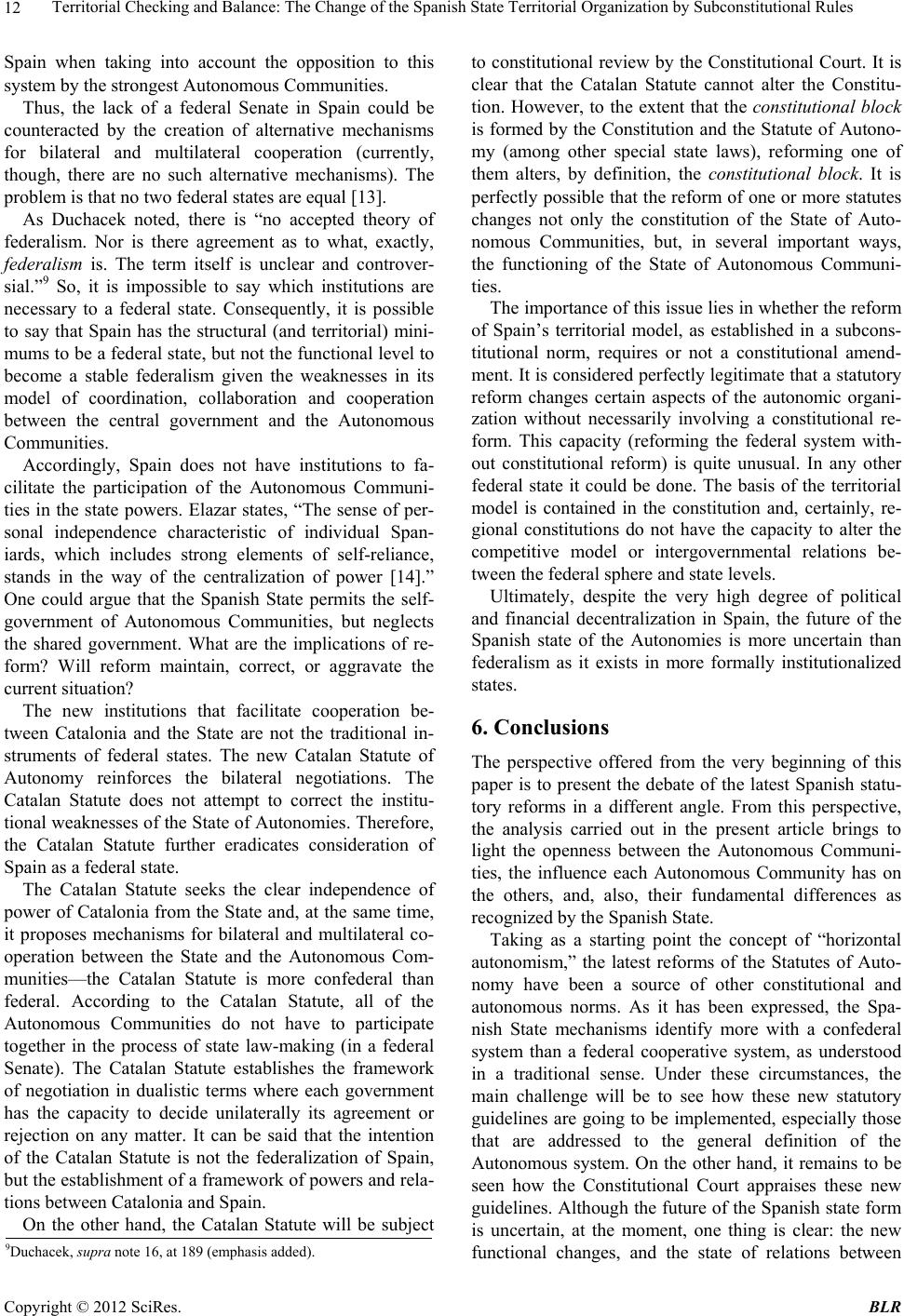 Territorial Checking and Balance: The Change of the Spanish State Territorial Organization by Subconstitutional Rules 12 Spain when taking into account the opposition to this system by the strongest Autonomous Communities. Thus, the lack of a federal Senate in Spain could be counteracted by the creation of alternative mechanisms for bilateral and multilateral cooperation (currently, though, there are no such alternative mechanisms). The problem is that no two federal states are equal [13]. As Duchacek noted, there is “no accepted theory of federalism. Nor is there agreement as to what, exactly, federalism is. The term itself is unclear and controver- sial.”9 So, it is impossible to say which institutions are necessary to a federal state. Consequently, it is possible to say that Spain has the structural (and territorial) mini- mums to be a federal state, but not the functional level to become a stable federalism given the weaknesses in its model of coordination, collaboration and cooperation between the central government and the Autonomous Communities. Accordingly, Spain does not have institutions to fa- cilitate the participation of the Autonomous Communi- ties in the state powers. Elazar states, “The sense of per- sonal independence characteristic of individual Span- iards, which includes strong elements of self-reliance, stands in the way of the centralization of power [14].” One could argue that the Spanish State permits the self- government of Autonomous Communities, but neglects the shared government. What are the implications of re- form? Will reform maintain, correct, or aggravate the current situation? The new institutions that facilitate cooperation be- tween Catalonia and the State are not the traditional in- struments of federal states. The new Catalan Statute of Autonomy reinforces the bilateral negotiations. The Catalan Statute does not attempt to correct the institu- tional weaknesses of the State of Autonomies. Therefore, the Catalan Statute further eradicates consideration of Spain as a federal state. The Catalan Statute seeks the clear independence of power of Catalonia from the State and, at the same time, it proposes mechanisms for bilateral and multilateral co- operation between the State and the Autonomous Com- munities—the Catalan Statute is more confederal than federal. According to the Catalan Statute, all of the Autonomous Communities do not have to participate together in the process of state law-making (in a federal Senate). The Catalan Statute establishes the framework of negotiation in dualistic terms where each government has the capacity to decide unilaterally its agreement or rejection on any matter. It can be said that the intention of the Catalan Statute is not the federalization of Spain, but the establishment of a framewo rk of powers and rela- tions between Catalonia and Spai n . On the other hand, the Catalan Statute will be subject to constitutional review by the Constitutional Court. It is clear that the Catalan Statute cannot alter the Constitu- tion. However, to the extent that the constitutional block is formed by the Constitution and the Statute of Autono- my (among other special state laws), reforming one of them alters, by definition, the constitutional block. It is perfectly possible that the reform of one or more statutes changes not only the constitution of the State of Auto- nomous Communities, but, in several important ways, the functioning of the State of Autonomous Communi- ties. The importance of this issue lies in wh ether the reform of Spain’s territorial model, as established in a subcons- titutional norm, requires or not a constitutional amend- ment. It is considered perfectly legiti mate that a statutory reform changes certain aspects of the autonomic organi- zation without necessarily involving a constitutional re- form. This capacity (reforming the federal system with- out constitutional reform) is quite unusual. In any other federal state it could be done. The basis of the territorial model is contained in the constitution and, certainly, re- gional constitutions do not have the capacity to alter the competitive model or intergovernmental relations be- tween the federal sphere and state levels. Ultimately, despite the very high degree of political and financial decentralization in Spain, the future of the Spanish state of the Autonomies is more uncertain than federalism as it exists in more formally institutionalized states. 6. Conclusions The perspective offered from the very beginning of this paper is to present the debate of the latest Spanish statu- tory reforms in a different angle. From this perspective, the analysis carried out in the present article brings to light the openness between the Autonomous Communi- ties, the influence each Autonomous Community has on the others, and, also, their fundamental differences as recognized by the Spanish State. Taking as a starting point the concept of “horizontal autonomism,” the latest reforms of the Statutes of Auto- nomy have been a source of other constitutional and autonomous norms. As it has been expressed, the Spa- nish State mechanisms identify more with a confederal system than a federal cooperative system, as understood in a traditional sense. Under these circumstances, the main challenge will be to see how these new statutory guidelines are going to be implemented, especially those that are addressed to the general definition of the Autonomous system. On the other hand, it remains to be seen how the Constitutional Court appraises these new guidelines. Although the future of the Spanish state fo rm is uncertain, at the moment, one thing is clear: the new functional changes, and the state of relations between 9Duchacek, supra note 16, at 189 (emphasis added). Copyright © 2012 SciRes. BLR 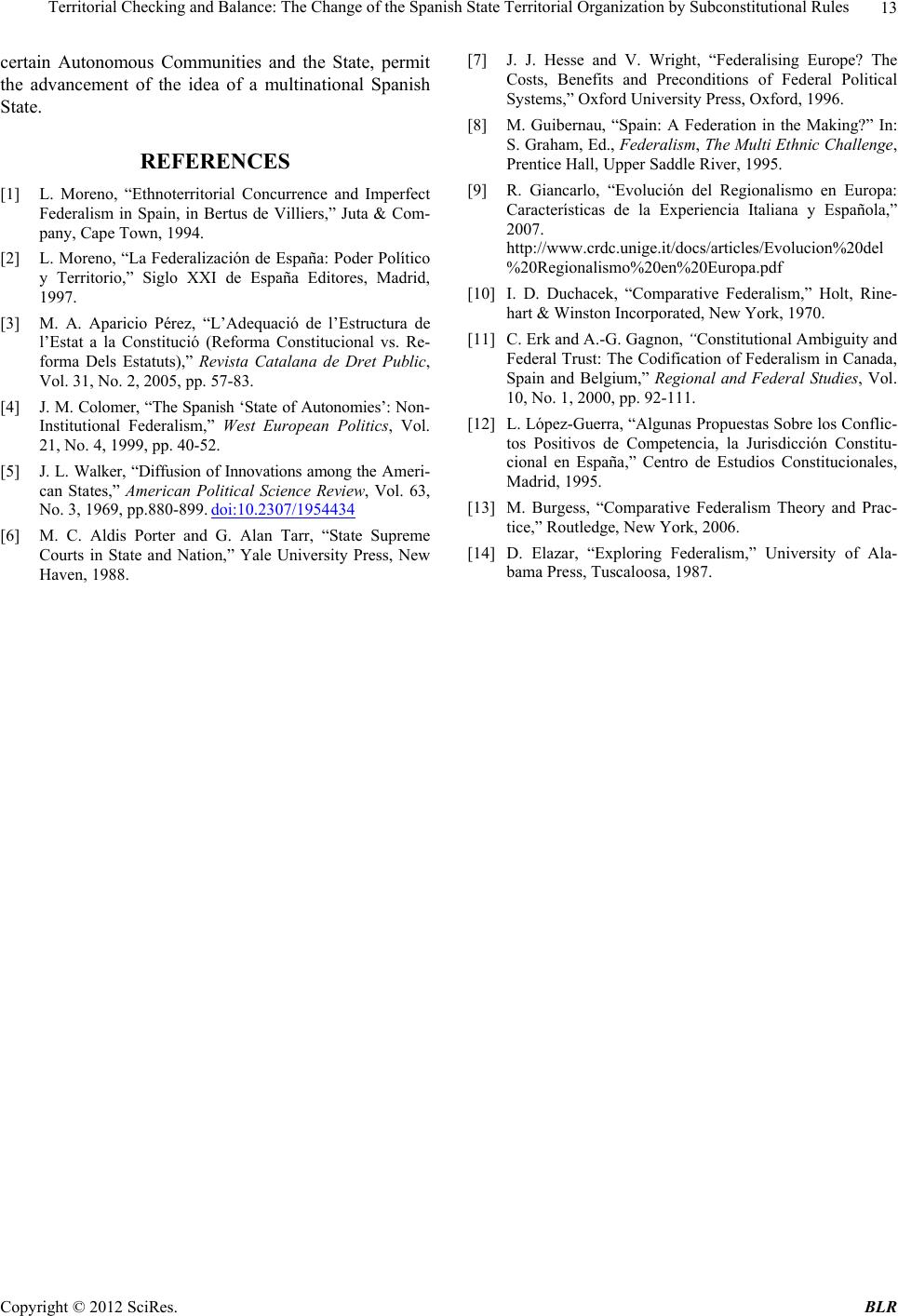 Territorial Checking and Balance: The Change of the Spanish State Territorial Organization by Subconstitutional Rules Copyright © 2012 SciRes. BLR 13 certain Autonomous Communities and the State, permit the advancement of the idea of a multinational Spanish State. REFERENCES [1] L. Moreno, “Ethnoterritorial Concurrence and Imperfect Federalism in Spain, in Bertus de Villiers,” Juta & Com- pany, Cape Town, 1994. [2] L. Moreno, “La Federalización de España: Poder Político y Territorio,” Siglo XXI de España Editores, Madrid, 1997. [3] M. A. Aparicio Pérez, “L’Adequació de l’Estructura de l’Estat a la Constitució (Reforma Constitucional vs. Re- forma Dels Estatuts),” Revista Catalana de Dret Public, Vol. 31, No. 2, 2005, pp. 57-83. [4] J. M. Colo mer, “The Spanish ‘Sta te of Autonomies’: No n- Institutional Federalism,” West European Politics, Vol. 21, No. 4, 1999, pp. 40-52. [5] J. L. Walker, “Diffusion of Innov ations among the Amer i- can States,” American Political Science Review, Vol. 63, No. 3, 1969, pp.880-899. doi:10.2307/1954434 [6] M. C. Aldis Porter and G. Alan Tarr, “State Supreme Courts in State and Nation,” Yale University Press, New Haven, 1988. [7] J. J. Hesse and V. Wright, “Federalising Europe? The Costs, Benefits and Preconditions of Federal Political Systems,” Oxford University Press, Oxford, 1996. [8] M. Guibernau, “Spain: A Federation in the Making?” In: S. Graham, Ed., Federalism, The Multi Ethnic Challenge, Prentice Hall, Upper Saddle River, 1995. [9] R. Giancarlo, “Evolución del Regionalismo en Europa: Características de la Experiencia Italiana y Española,” 2007. http://www.crdc.unige.it/docs/articles/Evolucion%20del %20Regionalismo%20en%20Europa.pdf [10] I. D. Duchacek, “Comparative Federalism,” Holt, Rine- hart & Winston Incorporated, New York, 1970. [11] C. Erk and A.-G. Gagnon, “Constitutional Ambiguity and Federal Trust: The Codification of Federalism in Canada, Spain and Belgium,” Regional and Federal Studies, Vol. 10, No. 1, 2000, pp. 92-111. [12] L. López-Guerra, “Algunas Propuestas Sobre los Conflic- tos Positivos de Competencia, la Jurisdicción Constitu- cional en España,” Centro de Estudios Constitucionales, Madrid, 1995. [13] M. Burgess, “Comparative Federalism Theory and Prac- tice,” Routledge, New York, 2006. [14] D. Elazar, “Exploring Federalism,” University of Ala- bama Press, Tuscaloosa, 1987.
|